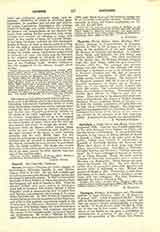

Castagno, ANDREA, or ANDREINO DEL, Florentine painter, b. near Florence, 1390; d. at Florence, August 9, 1457. Little is known of his life. Vasari tells us that his father was only a poor laborer and that the painter himself commenced life as a keeper of cattle. It is not known what led him to study art, or who was his first master. Izi 1434, after the return of the Medici, he was given a commission to commemorate in painting on the facade of the palace the execution of the Albizzi, the Peruzzi, etc. From that time he went by the name of “Andrea degli Impiccati”. In 1454 Pope Nicholas V commissioned him to decorate the apartments of the Vatican. Vasari recounts that Andrea, having learned the secret of oil-painting from Domenico Veneziano, and wishing to remain the sole master of the art, assassinated his comrade. It is known, however, that Domenico survived him four years. Castagno is one of the artists who, with Paolo Uccello (b. 1497) and Filippo Lippi (b. 1406), contributed most actively to the Masaccio revolution in art. His works, however, show the influence of the frescoes of the Brancacci’s chapel. He was greatly influenced also by the work of the sculptor Donatello. He has neither the passion of the latter, nor the moral grandeur of Masaccio, nor the elegance of Lippi. But in his own domain, which is the perfecting of plastic and of the resources of drawing, no one has made more progress than he. His paintings have been scattered and cannot be studied anywhere but in Florence. The most celebrated of his works is the life-like and strongly-executed equestrian portrait of Niccolo da Tolentino, in the Cathedral of Florence, which forms the pendant to that of John Hawkwood by Uccello (1436). Most remarkable is the “Last Supper“, which hangs in the refectory of the old convent of S. Apollonia. The figures, almost colossal, have a power of anatomy, an individuality, a savage life which forces one to forget the absence of all religious emotion. Such characteristics are also found in the frescoes of the Villa Carducci, which are now at the National Museum. They represent Thomyris, Esther, and the Cumman Sibyl, the poets Dante, Petrarch, and Boccaccio, statesmen such as Acciaiuoli, Farinata degli Uberti, and, Pippo Spano. These last, by the energy of their attitude, the hang of their draperies, and their heroic aspect, produce an impression of grandeur and solemnity which is found nowhere in the Florentine school of the fourteenth century outside of the works of Masaccio and Signorelli.
LOUIS GILLET

